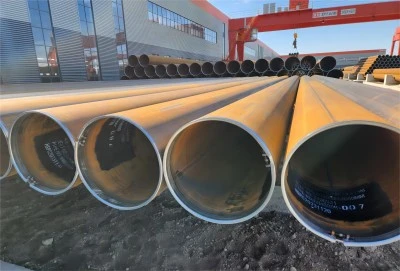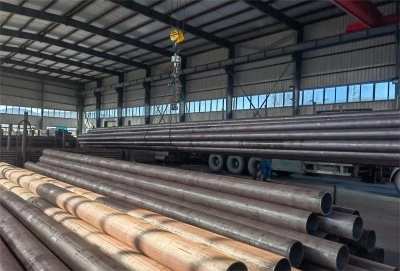When it comes to selecting the right pipe for your project, understanding the differences between various grades and specifications is crucial. In this article, we'll explore the distinctions between ASTM A53 Grade A and ASTM A53 Gr B pipes, two commonly used types of carbon steel pipes in various industries. By delving into their mechanical properties, strength, durability, and applications, we'll help you make an informed decision for your specific needs.
|
|
|
Key mechanical property differences between ASTM A53 Grade A and B pipe
ASTM A53 Grade A and Grade B pipes are both carbon steel pipes manufactured according to the ASTM A53 standard. However, they have some notable differences in their mechanical properties:
- Yield Strength: Grade B pipes have a higher minimum yield strength of 35,000 psi (240 MPa) compared to Grade A pipes, which have a minimum yield strength of 30,000 psi (205 MPa).
- Tensile Strength: Grade B pipes boast a higher minimum tensile strength of 60,000 psi (415 MPa), while Grade A pipes have a minimum tensile strength of 48,000 psi (330 MPa).
- Chemical Composition: Grade B pipes generally have a higher carbon content, which contributes to their increased strength.
- Elongation: Both grades have similar elongation requirements, with a minimum of 25% for longitudinal tension test specimens.
These mechanical property differences make Grade B pipes more suitable for applications requiring higher strength and pressure resistance. The increased yield and tensile strengths of Grade B pipes allow them to withstand greater stresses and loads compared to their Grade A counterparts.
How do ASTM A53 Grade A and B pipes compare in terms of strength and durability?
When comparing the strength and durability of ASTM A53 Grade A and B pipes, several factors come into play:
1.Strength Comparison:
As mentioned earlier, ASTM A53 Gr B pipes have higher yield and tensile strengths compared to Grade A pipes. This translates to:
- Better resistance to deformation under load
- Higher pressure-bearing capacity
- Improved performance in demanding structural applications
The increased strength of Grade B pipes makes them more suitable for applications where higher pressures or loads are expected. This can lead to improved safety margins and potentially allow for the use of thinner-walled pipes in certain situations, resulting in weight and cost savings.
2.Durability Factors:
While strength is an important aspect of durability, other factors also contribute to the overall longevity and performance of the pipes:
- Corrosion Resistance: Both Grade A and B pipes have similar corrosion resistance properties. However, the slightly higher carbon content in Grade B pipes may marginally affect their corrosion resistance in certain environments.
- Weldability: Grade A pipes are generally considered to have better weldability due to their lower carbon content. Grade B pipes, while still weldable, may require more careful welding procedures to prevent issues such as cracking or embrittlement in the heat-affected zone.
- Fatigue Resistance: The higher strength of ASTM A53 Gr B pipes can contribute to improved fatigue resistance in cyclic loading applications.
- Impact Toughness: Both grades have similar impact toughness properties, but the higher carbon content in Grade B pipes may slightly reduce their low-temperature impact toughness.
It's important to note that while Grade B pipes generally offer superior strength and durability in many applications, the choice between Grade A and B should be based on the specific requirements of your project. Factors such as operating conditions, environmental factors, and regulatory requirements should all be considered when making your selection.
Application differences between ASTM A53 Grade A and B pipes
The mechanical property differences between ASTM A53 Grade A and B pipes lead to some distinct applications for each grade. Let's explore the typical uses for both grades:
1.ASTM A53 Grade A Pipe Applications:
Grade A pipes are commonly used in applications where moderate strength is sufficient and where weldability is a priority. Some typical applications include:
- Low-pressure plumbing systems
- Fire sprinkler systems
- HVAC systems
- General-purpose structural applications
- Fencing and railings
- Light-duty process piping
Grade A pipes are often chosen for projects where cost-effectiveness is a primary concern and where the higher strength of Grade B pipes is not necessary.
2.ASTM A53 Grade B Pipe Applications:
ASTM A53 Gr B pipes, with their higher strength properties, are typically used in more demanding applications, including:
- High-pressure pipelines
- Oil and gas transmission lines
- Petrochemical plants
- Power generation facilities
- Heavy-duty structural applications
- Construction of bridges and large buildings
- Industrial process piping
The superior strength of Grade B pipes makes them the preferred choice for applications where safety, reliability, and performance under high stress are critical factors.
3.Considerations for Choosing Between Grade A and B:
When deciding between ASTM A53 Grade A and B pipes for your project, consider the following factors:
- Operating Pressure: If your application involves high pressures, Grade B pipes are likely the better choice due to their higher strength.
- Structural Requirements: For load-bearing applications, Grade B pipes offer better performance and may allow for the use of smaller pipe sizes or thinner walls.
- Welding Requirements: If extensive welding is required, especially in field conditions, Grade A pipes may be preferable due to their better weldability.
- Cost Considerations: Grade A pipes are generally less expensive than Grade B pipes. If your application doesn't require the higher strength of Grade B, opting for Grade A can lead to cost savings.
- Regulatory Compliance: Ensure that the grade you choose meets all relevant industry standards and regulations for your specific application.
- Future Expansion: Consider potential future needs or upgrades. Choosing Grade B pipes may provide additional capacity for future expansion or increased demands.
Longma Group:
When selecting between these two grades, it's crucial to carefully evaluate your project's specific requirements, including operating conditions, structural needs, and long-term goals. By understanding the differences between ASTM A53 Grade A and B pipes, you can make an informed decision that ensures optimal performance, safety, and cost-effectiveness for your piping system.
If you're looking for high-quality ASTM A53 Gr B Pipe for your next project, look no further than Longma Group. Our extensive range of pipes, including outer diameters from 1/2" to 80" and thicknesses from SCH10 to SCH160, ensures we have the right solution for your needs. Contact us at info@longma-group.com to discuss your requirements and how we can help you choose the perfect pipe for your application.














